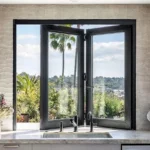Cooking on a gas stove brings that satisfying flame and precise heat control many home chefs love. But it also releases smoke, grease, and potentially harmful gases into your kitchen air. That’s where a good range hood comes in. A range hood for gas stove acts as your kitchen’s guardian, pulling away those unwanted elements to keep your space clean, safe, and comfortable. In today’s fast-paced world, where home cooking is booming, investing in the right ventilation system isn’t just a luxury—it’s a smart move for health and home value.
Understanding the Basics of Range Hoods for Gas Stoves
Range hoods aren’t one-size-fits-all. They come in various styles to match your kitchen setup and cooking habits. For gas stoves, which produce more heat and emissions than electric ones, you need a hood that handles high BTUs effectively.
Common types include:
- Under-Cabinet Hoods: These fit snugly beneath your cabinets, saving space. They’re ideal for compact kitchens and offer strong suction without dominating the room.
- Wall-Mount Hoods: Mounted directly on the wall, these provide a sleek, chimney-like look. They work well in open layouts and often feature adjustable heights for custom fit.
- Commercial-Style Hoods: Built for heavy-duty use, these are perfect if you cook like a pro. Check out options in the commercial range hood lineup for robust models that tackle intense grilling or frying.
Each type ventilates through ducted or ductless systems. Ducted hoods expel air outside for maximum efficiency, while ductless ones recirculate filtered air—great for apartments without exterior vents.
Why focus on gas stoves? Gas burners release carbon monoxide, nitrogen dioxide, and other pollutants. A proper hood captures these at the source, preventing them from spreading.
Key Benefits of Installing a Range Hood for Gas Stove
A range hood does more than just suck up smoke. It transforms your cooking experience and protects your home. Here are the top advantages:
- Improved Indoor Air Quality: Gas stoves emit harmful fumes. A hood removes these, reducing risks of respiratory issues. Studies show venting can cut airborne pollutants by up to 90%.
- Odor and Grease Control: Say goodbye to lingering fish or spice smells. Hoods trap grease particles, keeping cabinets and walls cleaner. This means less scrubbing and a fresher kitchen overall.
- Enhanced Safety: Many modern hoods include gas leak detectors that alert you to dangers. For high-BTU stoves, strong suction (like 950 CFM) prevents buildup of combustible vapors, lowering fire risks.
- Better Kitchen Comfort: Heat from gas flames can make cooking sweaty work. Hoods vent hot air, keeping temperatures down. Plus, they often include LED lights for better visibility over your stove.
- Noise Reduction and Convenience: Quiet operation (around 60-65 dB) lets you chat while cooking. Smart features, like app controls, add hands-free ease.
In short, a range hood for gas stove isn’t just functional—it’s a health booster. Families with kids or allergies especially benefit from the cleaner air it provides.
Common Challenges in Choosing and Installing a Range Hood
Picking the perfect hood involves more than aesthetics. Several hurdles can trip you up, but knowing them helps you navigate smoothly.
First, sizing matters. Your hood should be at least as wide as your stove—30 inches for a standard gas range, up to 36 for larger ones. Undersized hoods miss capturing fumes from the edges.
CFM (cubic feet per minute) is another key factor. For gas stoves, aim for 100 CFM per 10,000 BTUs. A 50,000 BTU stove needs at least 500 CFM; pros recommend 700+ for frequent heavy cooking.
Installation poses its own challenges:
- Ducting Decisions: Ducted setups require venting to the outside, which might involve cutting holes in walls or roofs. Ductless is easier but less powerful for gas emissions.
- Height Placement: Install 24-30 inches above the stove for optimal capture. Too high, and efficiency drops; too low, and it risks fire hazards.
- Power and Wiring: Ensure your kitchen has the right electrical setup. Some hoods need dedicated circuits, especially smart models.
- Noise and Maintenance: High-CFM hoods can be loud—check decibel ratings. Filters need regular cleaning; forget this, and performance suffers.
Budget is a factor too. Basic models start affordable, but commercial range hood options with advanced features cost more. Professional installation adds $200-500, but it’s worth it to avoid mistakes like poor sealing that leads to leaks.
Overcoming these? Measure your space, calculate BTUs, and consult manuals. If unsure, hire a pro to ensure safety and compliance with local codes.
Emerging Trends in Range Hoods for 2025
Kitchen tech evolves quickly, and range hoods are no exception. In 2025, trends focus on smart, sustainable, and stylish designs that blend with modern homes.
- Smart Integration: Wi-Fi-enabled hoods connect to apps, Alexa, or Google Home. Control speeds remotely or get filter cleaning reminders. Voice commands make cooking hands-free.
- Eco-Friendly Features: Energy-efficient motors and recyclable materials are big. Look for hoods with plasma purification systems that neutralize odors without harsh chemicals.
- Minimalist Aesthetics: Clean lines, brushed metals, and glass accents dominate. Brass or copper finishes add warmth, fitting trendy warm-toned kitchens.
- High-Efficiency Ventilation: Boost modes handle intense gas stove sessions. Odor-eliminating tech, like advanced carbon filters, keeps air pure.
- Portable and Versatile Options: For flexible cooking, compact models suit small spaces or rentals. Dual-mode hoods switch between ducted and ductless easily.
Sustainability shines through with low-energy LEDs and quiet operation. As gas stoves remain popular, hoods with built-in sensors for gas detection are gaining traction for safety-conscious homeowners.
These trends make hoods more than utilities—they’re design statements. Explore commercial range hood collections for cutting-edge examples that embody these innovations.
Maintenance Tips to Keep Your Range Hood Performing
A well-maintained hood lasts longer and works better. Simple habits prevent issues down the line.
Start with filters: Baffle or mesh types catch grease—clean them monthly in the dishwasher. Carbon filters in ductless models need replacing every 3-6 months.
Wipe the exterior weekly with mild soap to avoid buildup. For stainless steel, use a soft cloth to prevent scratches.
Check ducts annually for blockages, especially in ducted systems. A clogged vent reduces suction and strains the motor.
Listen for unusual noises; they signal loose parts or worn motors. Reset cleaning reminders after servicing to stay on track.
Regular care ensures your range hood for gas stove stays efficient, saving energy and extending its life to 10+ years.
How to Select the Right Range Hood for Your Needs
Ready to buy? Follow these steps:
- Assess your stove: Note BTUs and size to match CFM and width.
- Consider your kitchen: Wall-mount for islands, under-cabinet for tight spots.
- Prioritize features: Gas detection for safety, smart controls for convenience.
- Set a budget: Balance cost with quality—invest in durable materials like 304 stainless steel.
- Read reviews: Look for real-user feedback on noise and ease of install.
Learn more about: Unboxing: Professional Range Hood
Final Thoughts
A range hood for gas stove is your kitchen’s unsung hero, boosting air quality, safety, and comfort while tackling smoke and odors head-on. From powerful benefits like health protection to navigating challenges like proper sizing, we’ve covered the essentials. With 2025 trends leaning toward smart, eco-friendly designs, now’s a great time to upgrade.






